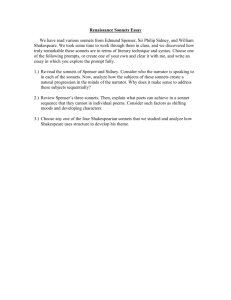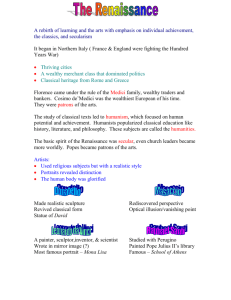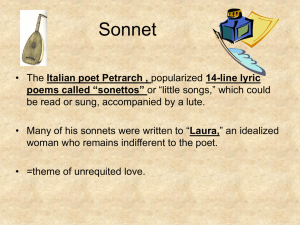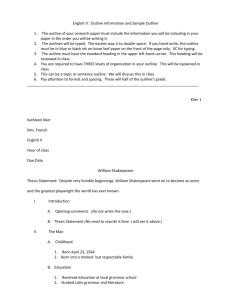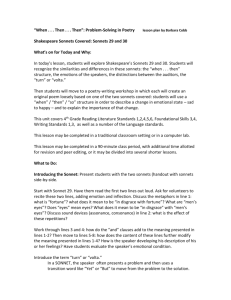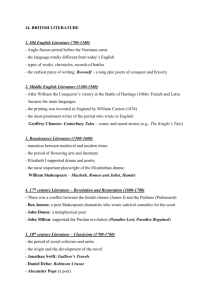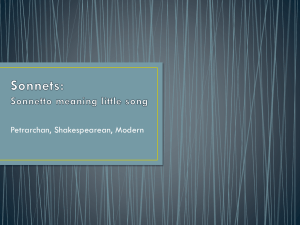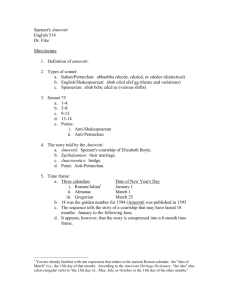Stiahnuť prednášku
advertisement
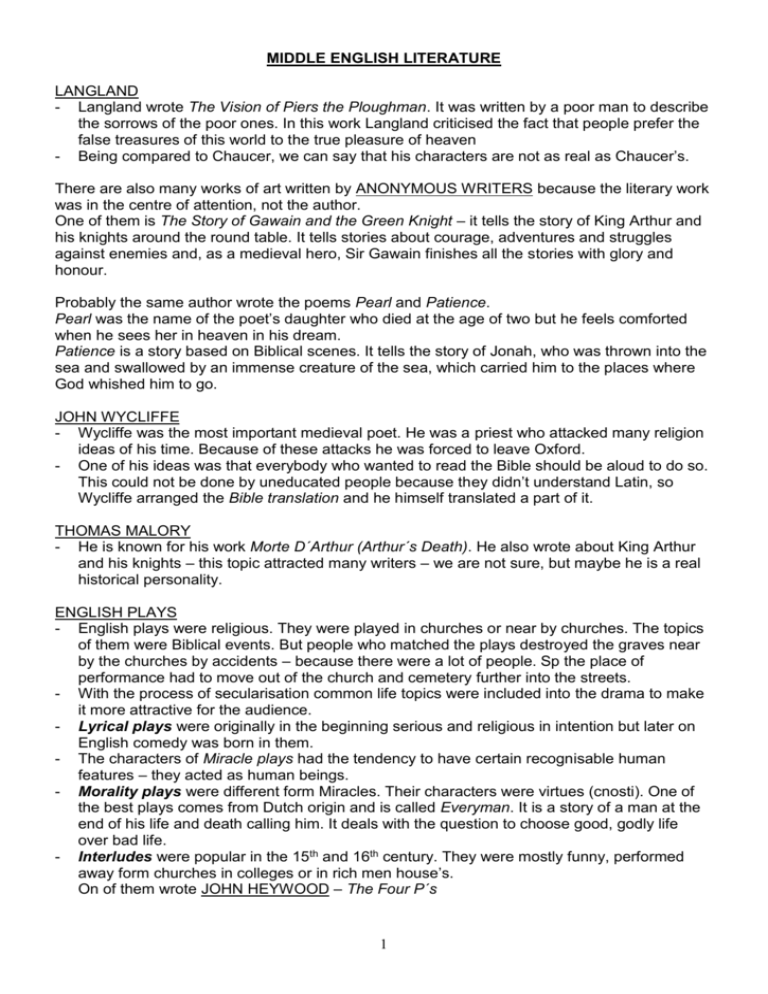
MIDDLE ENGLISH LITERATURE LANGLAND - Langland wrote The Vision of Piers the Ploughman. It was written by a poor man to describe the sorrows of the poor ones. In this work Langland criticised the fact that people prefer the false treasures of this world to the true pleasure of heaven - Being compared to Chaucer, we can say that his characters are not as real as Chaucer’s. There are also many works of art written by ANONYMOUS WRITERS because the literary work was in the centre of attention, not the author. One of them is The Story of Gawain and the Green Knight – it tells the story of King Arthur and his knights around the round table. It tells stories about courage, adventures and struggles against enemies and, as a medieval hero, Sir Gawain finishes all the stories with glory and honour. Probably the same author wrote the poems Pearl and Patience. Pearl was the name of the poet’s daughter who died at the age of two but he feels comforted when he sees her in heaven in his dream. Patience is a story based on Biblical scenes. It tells the story of Jonah, who was thrown into the sea and swallowed by an immense creature of the sea, which carried him to the places where God whished him to go. JOHN WYCLIFFE - Wycliffe was the most important medieval poet. He was a priest who attacked many religion ideas of his time. Because of these attacks he was forced to leave Oxford. - One of his ideas was that everybody who wanted to read the Bible should be aloud to do so. This could not be done by uneducated people because they didn’t understand Latin, so Wycliffe arranged the Bible translation and he himself translated a part of it. THOMAS MALORY - He is known for his work Morte D´Arthur (Arthur´s Death). He also wrote about King Arthur and his knights – this topic attracted many writers – we are not sure, but maybe he is a real historical personality. ENGLISH PLAYS - English plays were religious. They were played in churches or near by churches. The topics of them were Biblical events. But people who matched the plays destroyed the graves near by the churches by accidents – because there were a lot of people. Sp the place of performance had to move out of the church and cemetery further into the streets. - With the process of secularisation common life topics were included into the drama to make it more attractive for the audience. - Lyrical plays were originally in the beginning serious and religious in intention but later on English comedy was born in them. - The characters of Miracle plays had the tendency to have certain recognisable human features – they acted as human beings. - Morality plays were different form Miracles. Their characters were virtues (cnosti). One of the best plays comes from Dutch origin and is called Everyman. It is a story of a man at the end of his life and death calling him. It deals with the question to choose good, godly life over bad life. - Interludes were popular in the 15th and 16th century. They were mostly funny, performed away form churches in colleges or in rich men house’s. On of them wrote JOHN HEYWOOD – The Four P´s 1 MEDIEVAL LITERATURE - lasted from 1066 – 1458 extensive influence of French literature on native English forms and themes From the Norman-French conquest of England in 1066 to the late 14th century French largely replaced English in ordinary literary compositions and Latin maintained its role as a language of liturgical works. By the 14th century, when English again became the chosen language of the ruling classes, it had lost much of its old English inflectional system. It had undergone curtain phonetic changes and it had acquired a number of foreign words – mainly French ad Latin once. Various dialects of Middle English spoken in the 14th century were similar to modern English and can be red without serious difficulties. French and Latin influenced Middle English mainly in the southern part. Middle Ages was a period of wars, deceases, crusades and Christianity. The social structure of Middle Ages was organised around the system of feudalism. This meant that the country wasn’t ruled by the king, but by individual lords and barons. They declared their own justice. They minted their own money. They had the right to decide about taxes and tolls. They also demanded military service form their vassals. They’ve got land from him and on the other hand he had to protect his vassals. Literature covered the period between 11th and 15th century and produced mainly religious and secular works. It repeated topics form Bible and Antique. The main characters were clerics, knights and kings – higher upper class. Works produced legends, poems, narratives, epics and heroic novels. Chaucer’s tales take place in spring, the words are dynamic, the people long to go on a pilgrimage. A pilgrimage combines vacations, travel and a spiritual renewal. Spring symbolises rebirth and fresh beginnings and therefore Chaucer chose spring as an opening to his tales The way the people, the characters look like and the way they are dressed is extremely important in tales as they reveal the real character of a person. 2 ELIZABETHAN POETRY AND PROSE. SONNETS THOMAS WYATT Thomas Wyatt is famous for introducing sonnets into English poetry. He translated several works of Petrarch but also edited, produced several of his own. We have few imitations of the works of classical authors mainly Seneca and Horace and also Wyatt experimented with songs, epigrams and satires. Wyatt admired Geoffrey Chaucer and his vocabulary reflects Chaucer’s. His best known poems are those which deal with romantic love. THE SONNET IN THE ENGLISH LITERATURE Sonnets were introduced by Thomas Wyatt in the early 16th century. His sonnets and sonnets of his contemporaries, like Earl of Surrey, were mainly translations form the Italian and French. Wyatt introduced the sonnet, but it was Earls of Surrey who gave the rhyme, scheme, rhythm and division into quatrains (štvorveršie). In the following years, William Shakespeare, Edmund Spenser, Samuel Daniel and many others wrote their sonnets. Majority of them were inspired by the Italian tradition and they treated mainly the poet’s love for women. In the 17th century sonnet was adopted for other purposes – religious once. John Milton and John Donne produced sonnets and they used them as a meditative poem. The fashion of sonnets went out with the restoration and hardly any sonnets were written between 1670s and the time of William Wordsworth. Later on sonnets came back with the French revolution. THE FORM OF SONNETS It was soon after the introduction of the Italian sonnet, when English sonnets began to be developed fully in native form. Poets who produced their sonnets were Sir Philip Sidney, Michael Drayton, Samuel Daniel and, of course. William Shakespeare. The form is often named after Shakespeare, not because he was the first on to write in this form, but because he became its first and most famous practitioner. The form consists of 3x4 + couplet (14 lines). A couplet generally introduced an unexpected sharp turn called a Volta. The rhyme scheme was ABAB CDCD EFEF GG – were GG is the couplet. Sonnets were written in iambic pentameter which means there are 10 syllables in each line and every other syllable is naturally stressed. EDMUND SPENSER Edmund Spenser is an important English poet best known for his work “The Fairy Queen” – which celebrates the Tudor Monarchy and Elisabeth I. Spenser was admired by William Wordsworth, John Keab, Lord Byron, Alfred Lord Tennyson and many others. The language of his poetry was such as Chaucer’s “Canterbury Tales”. His “Epithalamion” is the most admired of its type in English language. There is a sonnet named after Spenser – the Spenserian sonnet. Its scheme is ABAB BCBC CDCD EE. In Spenserian sonnet there does not appear to be a requirement that the initial octave set up a problem which the closing sestet (8+6=14 lines) answers. Instead of it the form is treated as 3 quatrains connected by rhyme and followed by a couplet. 3 GROUP OF METAPHYSICAL POETS They formed a loose group of British Lyric poets of the 17th century. They shared interests in metaphysical concerns and a common way of investigating them. The name Metaphysical Poets was given to them by Samuel Johnson. The poets themselves didn’t form a school or start a movement. Most of them even didn’t know or didn’t read each other. Their verse appeals to the reader’s intellect rather then to the emotions. Their style can be characterised by wit, subtle argumentations, unusual simile or metaphors. Several Metaphysical Poets, especially John Donne, were influenced by NeoPlatonism. On of its primary ideas is the idea that the perfection of beauty in the beloved acted as a remembrance of perfect beauty in the eternal kingdom. DRAMA DRAMA – 16th century – Renaissance. Drama is the most important genre in English literature and especially in the period of Renaissance where its great development can be seen. Generally speaking comedies are considered to be better constructed that tragedies. NICHOLAS UDALL is called the father of English comedy, especially with his comedy Ralph Roister Doister – the first English comedy. It contains the kind of humour which can be found among the country people. Similar to this is another drama Gammer Gurton´s Needle (1566). Its plot is about the loss and the finding o a needle with which Gammer Gurton makes the clothes. Quarrels, drinking and broken heads are important part of the drama. BEN JONSON, who was a dramatist, left many poems, plays and prose. Critics see his work as more learned and less inspired than Shakespeare’s. Inspired means showing influence of outside spirits upon the human mind. His best play was Every Man in his Humour. Humour should be understood as a quality, special foolishness, strong feeling in a man. His characters are more humorous and they are not really human. He wrote about 20 plays alone and several with other play writers. His play Sejanus His Fall was performed at the Globe Theatre and also his play Volpone the Fox had great access. Jonson was also an important producer of masques. These are dramatical entertainments with dancing and music, which are more important than the characters and story itself. Jonson believed in the classical unities of time, place and action. This means that the plays should take place in 1 location, the action should not cower more than 24 hours and nothing form outside was left into the story. His other plays are for example Every Man out of his Humour, Epicoene or the Silent Woman, The Alchemist or The Bartholomew Fair. Other dramatists were JOHN WEBSTER, JOHN FLETCHER and FRANCIS BEAUMONT. 4 PROSE The prose of this period doubt mainly with translations of Plutarch. THOMAS NORTH and his work The Lives of Noble Grecians and Romans is considered to be a quite important piece of prose. JOHN LYLY was employed at the court. He is known for his work Eupheus. He used his work as a place to express his ideas in various talks and letters. His style is full of tricks; his sentences are long and complicated. The readers forget about the thoughts behind the lines the focus on the sentence construction. This style of long, complicated sentences was typical for the conversation of ladies of that time and many of these ladies were Lyly´s pupils at the court. Even Queen Elisabeth I. used this style and it was necessary for every girl of a good family to learn this style. ROBERT GREEN also a playwright influenced Shakespeare, especially his work The Winter’s Tale. The main plot of The Winter's Tale is taken from Robert Greene's pastoral romance Pandosto, published in 1590. THOMAS NASH was an author of independent characters. He is famous for his work The Live of Jacky Hilton, which is a novel of adventures. We are talking here about Elisabethan novels, they re for a little value, only a few people read them. They died out in that period because it didn’t lead to a development of novels. FRANCIS BACON and his work Essays (1517). His sentences were short, sharp and effective. Some of the best known English sayings come from Essays. His work The New Atlantis deals with social ideas in the form of a story. He wrote several books in English and Latin. In this period in 1611 the first version of authorized Bible appears and the first complete version of Bible is the one of Wycliffe. WILLIAM TYNDALE, who translated The Old and the New Testament, is remembered for his translations. Because of his beliefs he was burnt. 47 translators were needed to translate the whole Bible and the translations were complete in 1611 with the first authorized Bible translation. 5 SHAKESPEAREAN PLAYS The best tragedies were written between 1601-1608: Hamlet, Othello, King Lear, Macbeth. Features: hero – noble man, moral weakness, hero’s life leading to death, inner and outer conflicts, abnormal conditions of mind (insanity) Tragic structure: exposition, rising action, falling action, resolution. HAMLET – contrast, inner monologues, soliloquy, main themes – revenge, family duty, love, “no act will stay without punishment” OTHELLO – jealousy, sexual one KING LEAR – based on the legend of King Lear of Britain, human suffering MACBETH – tragedy of murder, revenge, supernatural elements – witches HISTORIES – Henry IV, Henry V, Henry VI, Henry VIII, Richard II, Richard III COMEDIES – Merry Wives of Windsor, Midsummer Night’s Dream, The Merchant of Venice, As you like it 6 THE LIFE AND WORK OF JOHN MILTON JOHN MILTON was an English poet, a polemist, a civil servant for the English Commonwealth. He was born into wealth family, has private tutoring, studied in London, focused on Latin and Greek which were reflected in his work, in poetry mainly. He studied very hard, he wrote his first psalms at the age of 15, later studied on Christ College in Cambridge where he met American dissident and theologian Roger Williams. At Cambridge he wrote many of his poems – ode On the morning of Christ nativity, L’Allegro, The Passion, Il Penseroso After receiving master degree he undertook 6 years of self-directed private studies, wrote ancient and modern works on philosophy, theology, history, politics, literature he spoke 8 languages besides mother tongue. He continued to write poetry, nowadays known as Trinity Manuscript. After having finished education he set off to France and Italy. His journey was cut short 13 months later by the events of civil war in England. He made many friends in intellectual circles, he met famous and influential people. His 1st hand observation of what he saw as superstitious tyranny of Catholicism increased his hatred for absolutist, confessional states. After his return to England he put poetry aside and he started to write anti-Episcopal prose (proti cirkvi). His unhappy marriage with Mary Powell let him to write few pamphlets arguing the legality and morality of divorce. He received very hostile response and this made him right, his Aeropaditica which is his attack against censorship. He defended republican principles, represented by Commonwealth, his works from this period can be seen as an explicit defence of the regicide (kráľovražda). He published also autobiographical work The Fensio pro Se. In 1659 he published A Treatise of civil power which attacks the concept of a state church. When restoration was about to begin he wrote 2 additions of the work THE READY AND EASY WAY TO ESTABLISHING A FREE COMMONWEALTH its impassioned and bitter work blaming English people for black sliding of liberty. Upon of restoration in 1660 he went to Hiding For rest of his life. His principal work PARADISE LOST was composed by blind Milton between 16581664. it reflects his personal dispare (zúfalstvo) at the failure of revolution yet there is an ultimate optimism in human potention. Paradise regained and tragedy SAMSON AGONISTES follow. They also follow Milton’s post restoration political situation. GRAMMAR BOOK – are of logic, HISTORY OF BRITAIN. His only explicitly political tracts were those published in 1672 OF TRUE RELIGION. Here he requires tolerance in religion, except for Catholics. His unfinished religious manifesto DE DOCTRINA CHRISTIANA lays out many of his heretical views and it was not discovered and published until 1823. He died in 1674 of a kidney failure (zlyhanie obličiek). 7
